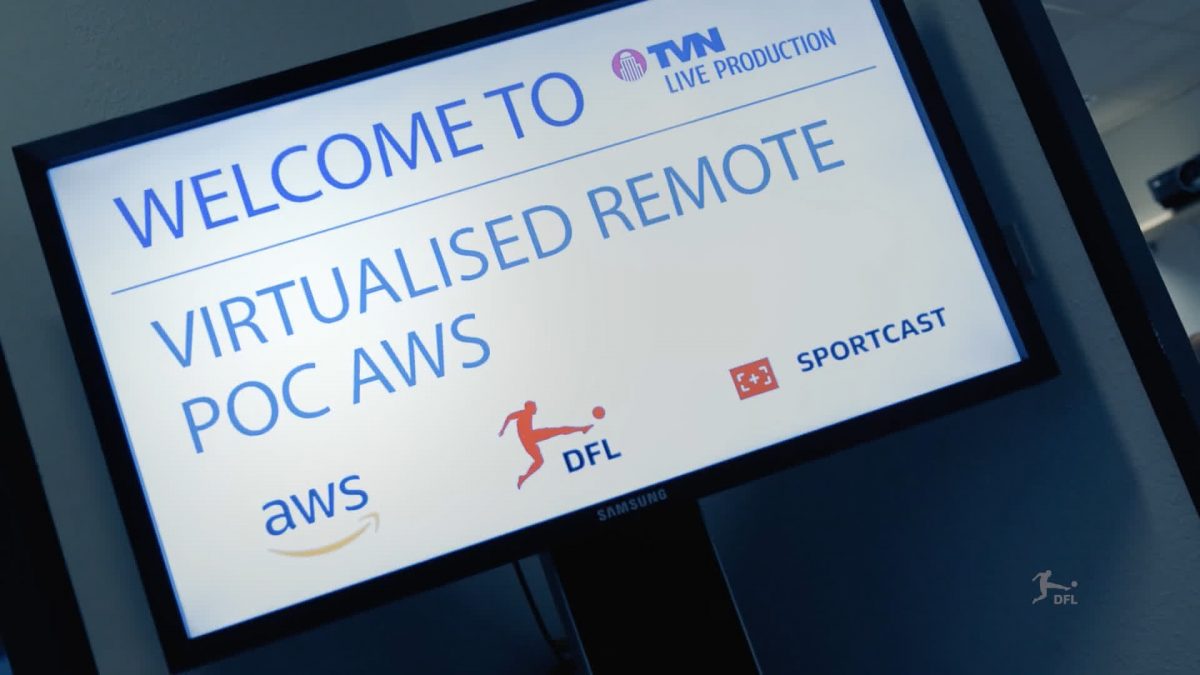DFL performs live tests of remote production technology

27 June 2023 – New technologies bring new opportunities to the production of sport media content. Cloud computing, super-fast 5G wireless networks, and innovative, AI-based production are some of the driving forces behind this development. DFL has been applying these technologies in various business areas for several years, including media production and distribution of Bundesliga and Bundesliga 2 content. Over the past months the DFL subsidiary Sportcast has run several remote production application tests.
First-ever remote production test in Bundesliga 2
In a remote production scenario, some of the staff works at a centralised production environment instead of the stadium where the actual match is taking place. This opens up new opportunities to streamline production processes and reduce resource consumption. Cloud-based remote production in 9:16 format was demonstrated successfully during the innovation matches at SportsInnovation 2022.
To explore the potential of this approach further, Sportcast conducted two additional tests during the 2022-23 season. In the first instance production took place remotely using conventional means of transmission. The second test was a pioneering global proof-of-concept (PoC) in which a Bundesliga 2 match between Fortuna Düsseldorf and Eintracht Braunschweig was produced entirely digitally, remotely and cloud-based in parallel with conventional production, using eleven cameras.
Luccas Roznowicz, Head of Digital Innovations at DFL GmbH, said about the importance of this test: “The DFL uses innovation throughout its ‘glass-to-glass’ strategy, from the camera lens in the stadium to the viewer’s TV or mobile screen. We support these efforts by making full use of our innovation ecosystem. In this case, we were able to combine our own production know-how with the cloud expertise of our global technology provider, Amazon Web Services.”

Successful collaboration with technology partners
For a successful test, a total of eleven market participants and their products and services had to be coordinated, reports Stefan Hausen, Technical Project Manager at Sportcast GmbH: “Amazon Web Services furnished the cloud platform. There were two suppliers whose production platforms were able to support our 10-bit workflow (refer to first infobox) while adhering to the highest quality standards: Grass Valley with their AMPP system and Evertz with the Dream Catcher system. The 8-bit workflow (refer to second infobox) we set up as a second system involved solutions by Vizrt and Simply Live which were integrated via an NDI protocol.”
About 10-bit/8-bit workflow
The term 10-bit workflow relates to the number of brightness levels in a video signal between deep black and the brightest part of a picture – a total of up to 1024 brightness levels. This corresponds to the broadcasting standard used for the DFL’s base signal. By contrast, an 8-bit signal offers up to 265 brightness levels, which is sufficient for streaming and certain other applications.
This has been a milestone achievement for DFL’s partnership with technology provider Amazon Web Services (AWS), stresses Shane Warden, Principal Consultant Sports at Amazon Web Services: “The challenge the DFL and we at AWS have set ourselves with our partners and vendors is to realise the ambition of creating a 4:2:2 10-bit live workflow (refer to second infobox) for a football match with professional operators at a scale which is driving us onwards towards our overall ambition: to create live and non-live content for sports while pushing our quality standard to the boundaries of what is technically possible today.”
About 4:2:2 colour resolution
4:2:2 denotes a coding method to reduce the data volume in colour transmission. Compared to brightness levels (refer to 10-bit/8-bit workflow infobox), the human eye is less sensitive to colour differences. This is why the colour resolution does not have to be as high as the brightness information, allowing the volume of the transmitted data to be reduced.
Familiar operating features for the production team
“It was very important to our customer DFL, but also for the operators, the freelance crew, to make sure that as a creative experience it’s every bit as familiar as it would be in a traditional production environment,“ said David Sabine, Principal Broadcast Consultant at Amazon Web Services. “All the user interfaces and mix panels are very familiar so there is no extra training or familiarisation time involved.”

Following an eight-week project planning phase, the crew set up the equipment at the Düsseldorf stadium and at the remote production site in Hanover within five days. Stefan Hausen reports about virtualised remote production in the AWS cloud: “Here at the production team we receive the camera signal from the outside broadcasting van located at the stadium. We have set-up a shadow production scenario that duplicates the set of cameras that normally record the match. The 10-bit colour depth standard we implemented for the first time is a new milestone in cloud-based production.”
Paving the way to next-generation live production
From three live tests conducted over the past months DFL has gained substantial expertise in the field of remote production of matches. The results of all tests were recorded meticulously to serve as a basis for the next development steps. “Now we know what current technologies can accomplish and where the limits are,” says Tim Achberger, Director Technology & Product Management at Sportcast GmbH, referring to the lessons learned from these tests. “It has been, and will always be, our goal to produce the Bundesliga and Bundesliga 2 matches in top quality. In pursuing this goal we are always looking for ways to incorporate the latest technologies in our future production model.” All parties involved in the PoC did an outstanding job, he emphasises, adding: “We now have a much broader knowledge basis as we explore our options to transform our media production.”


